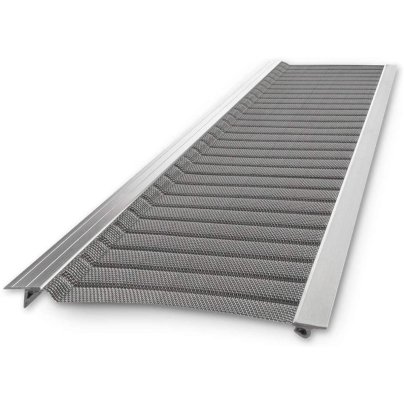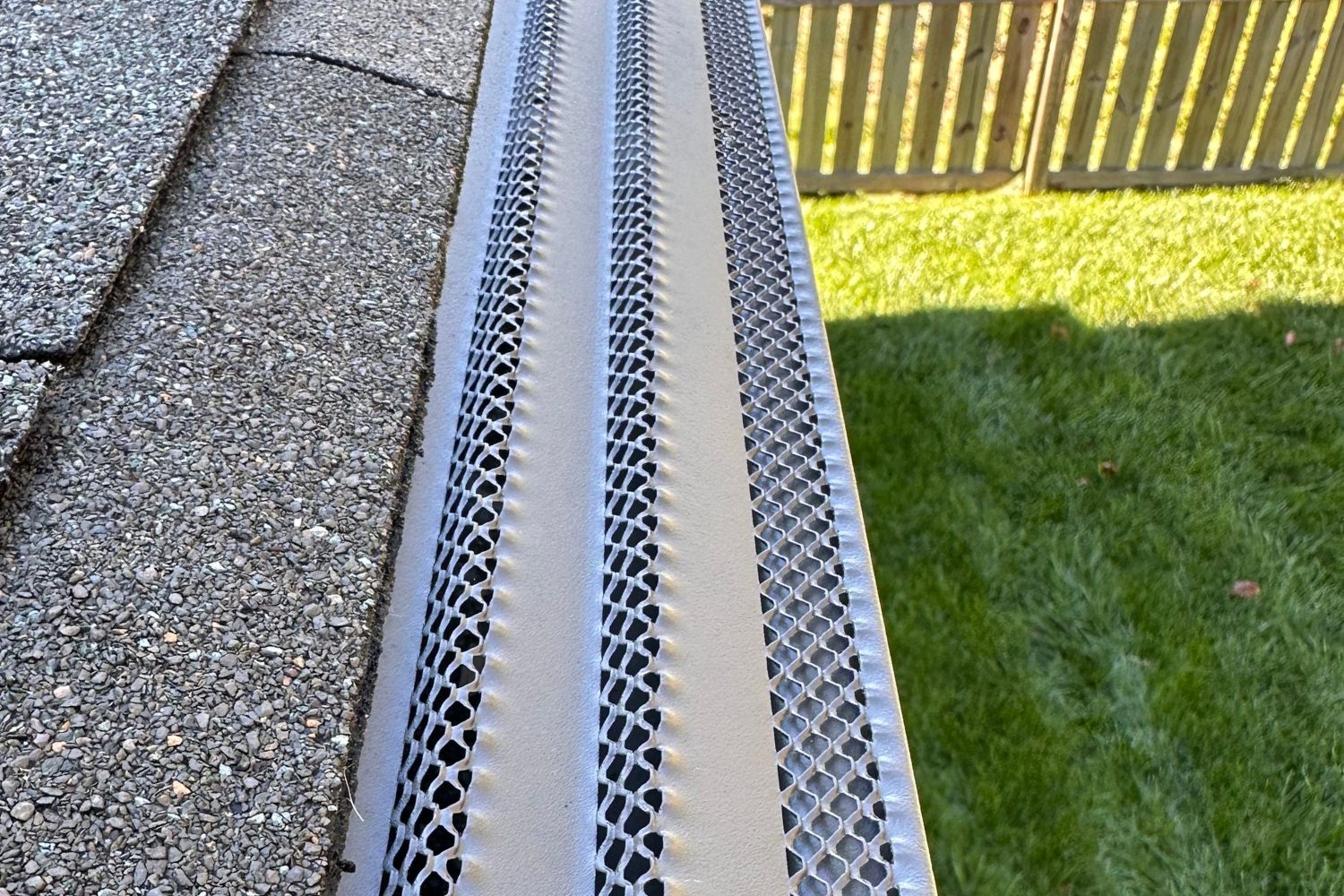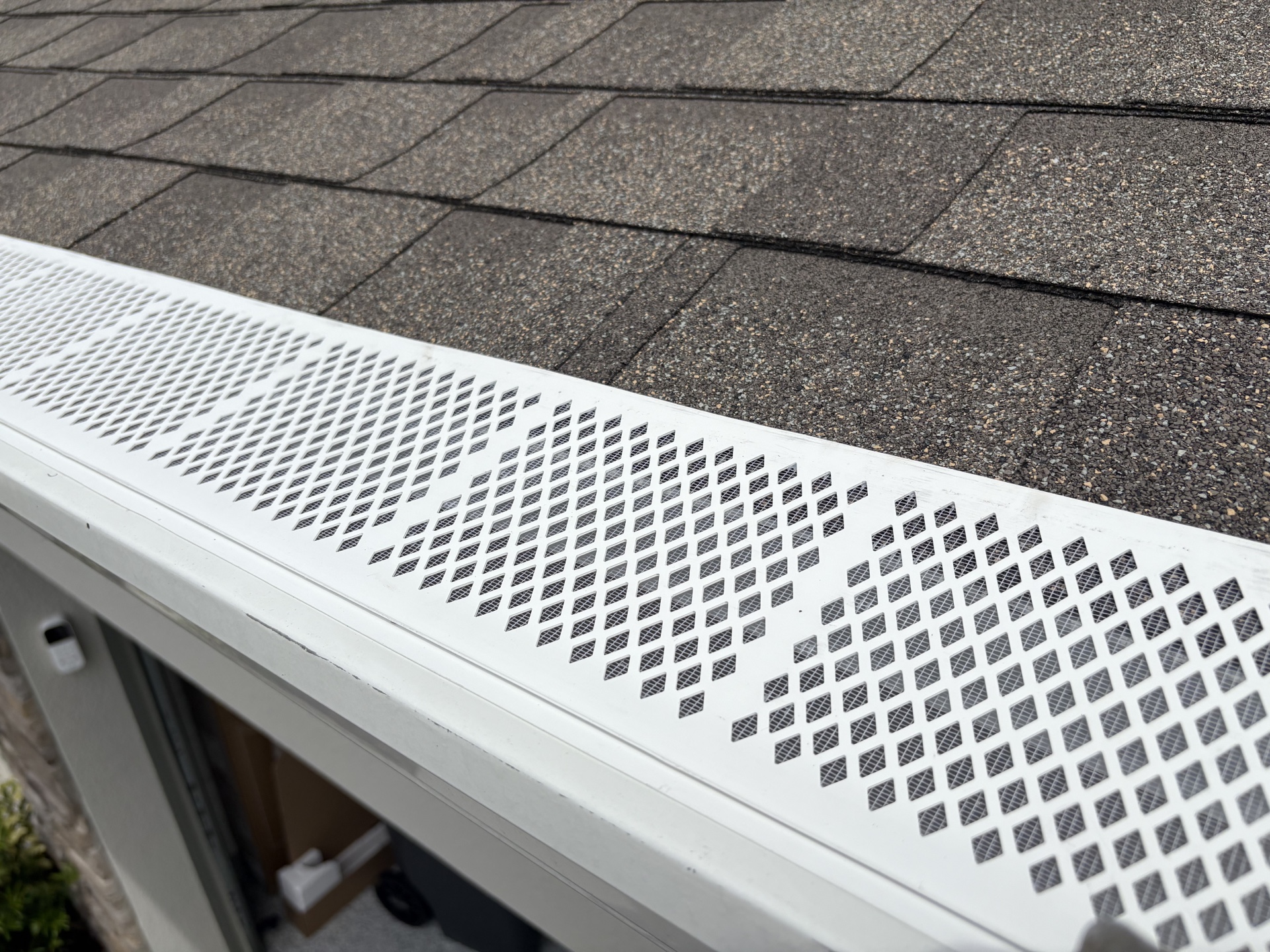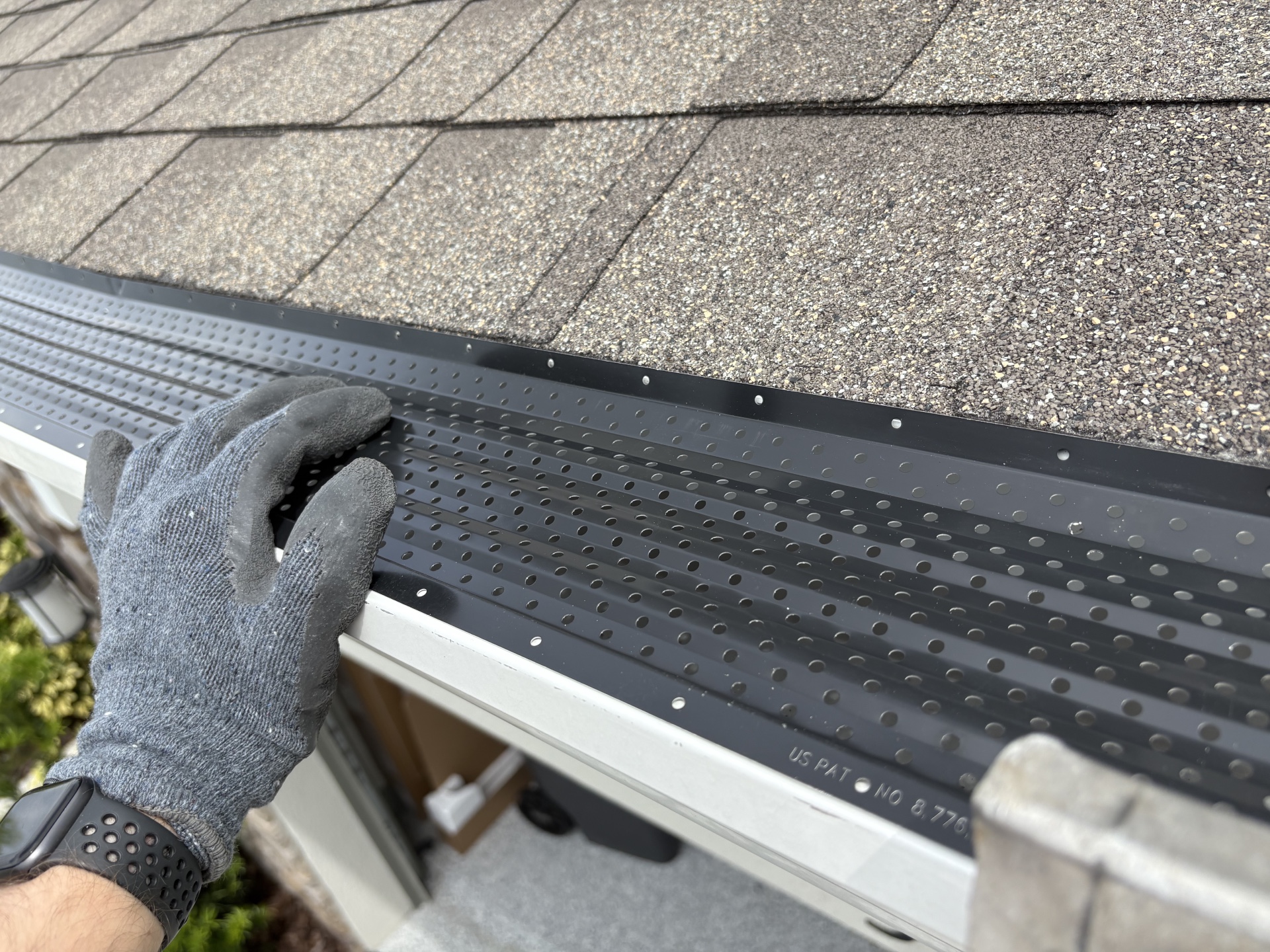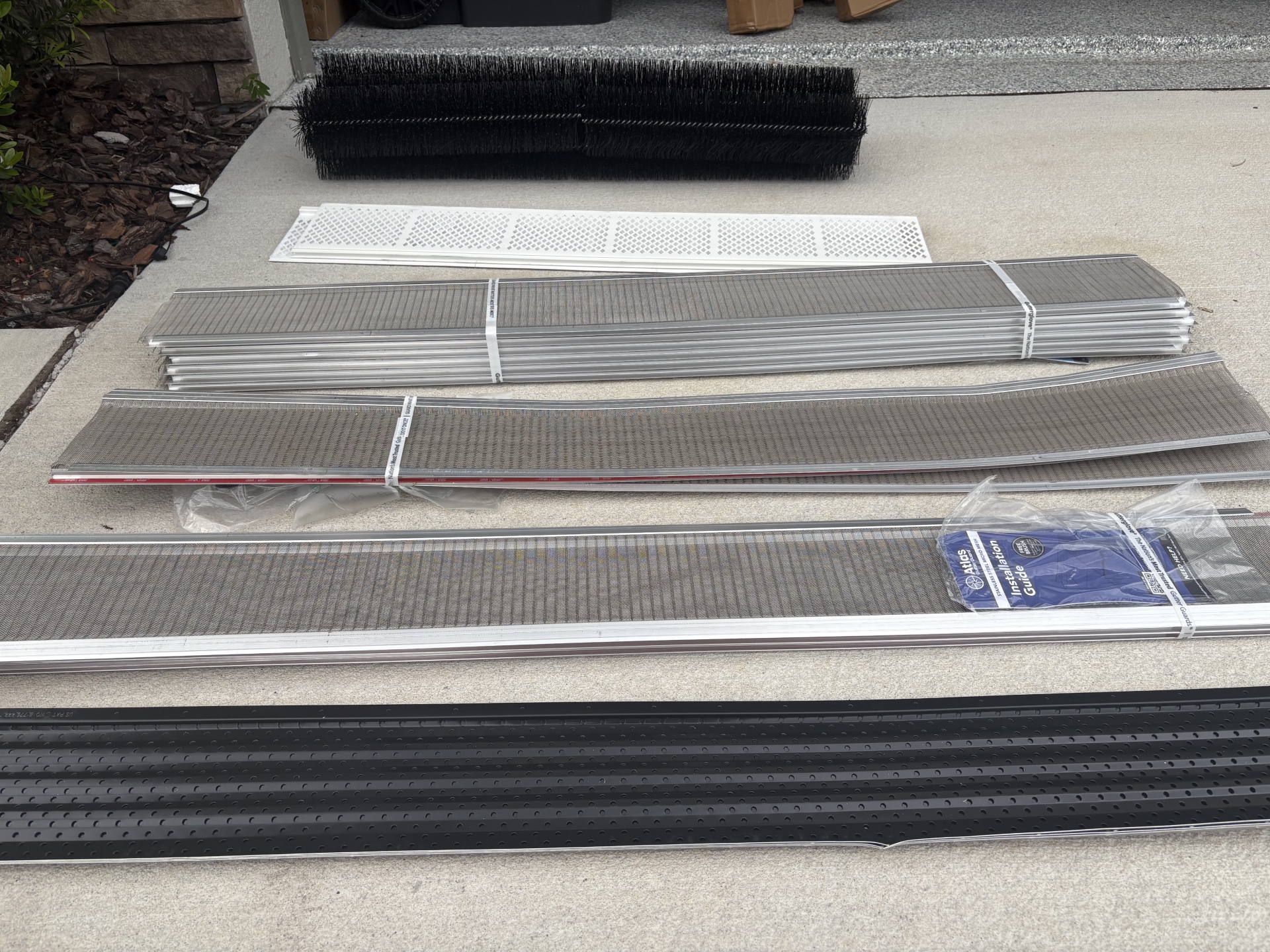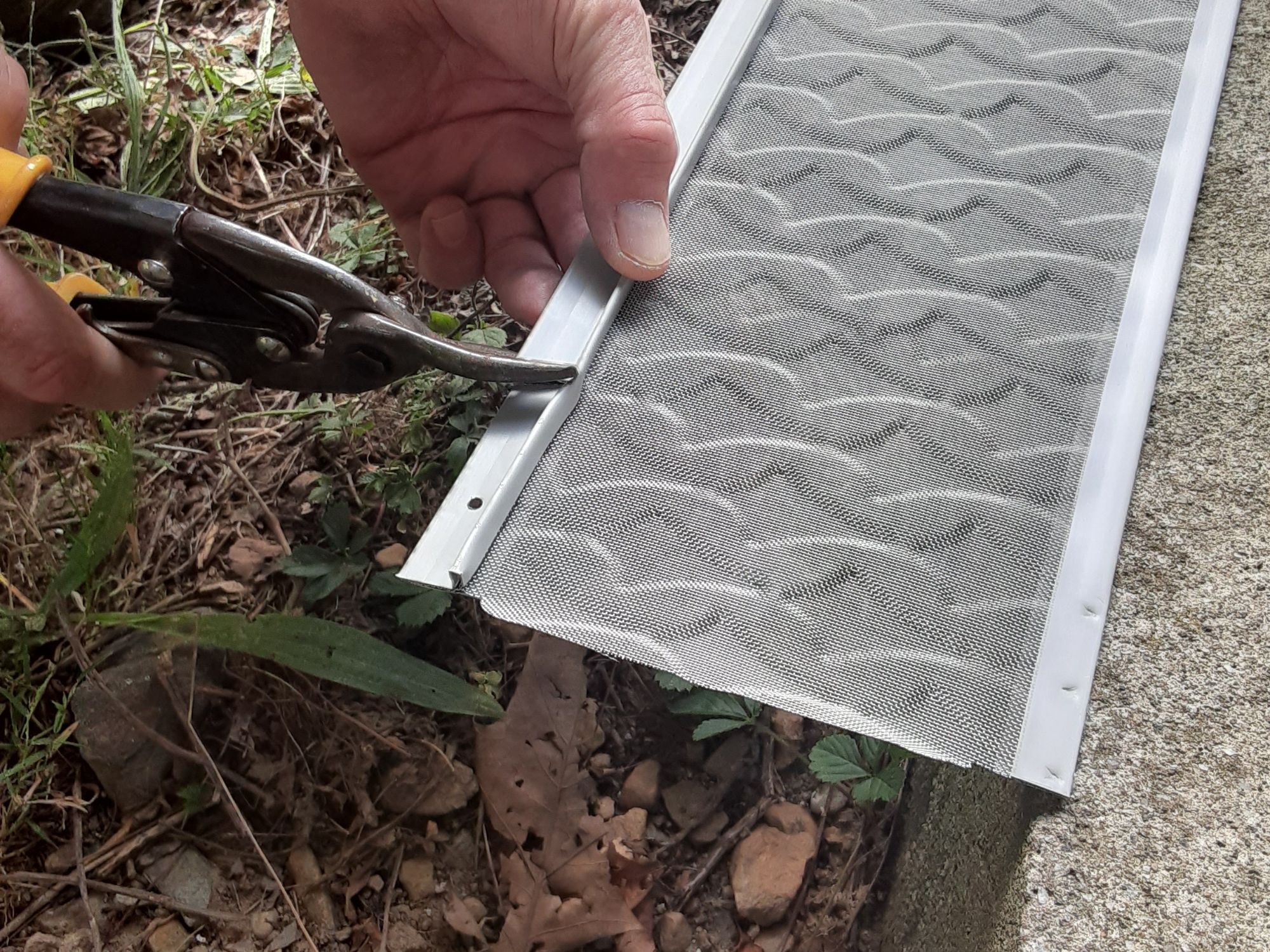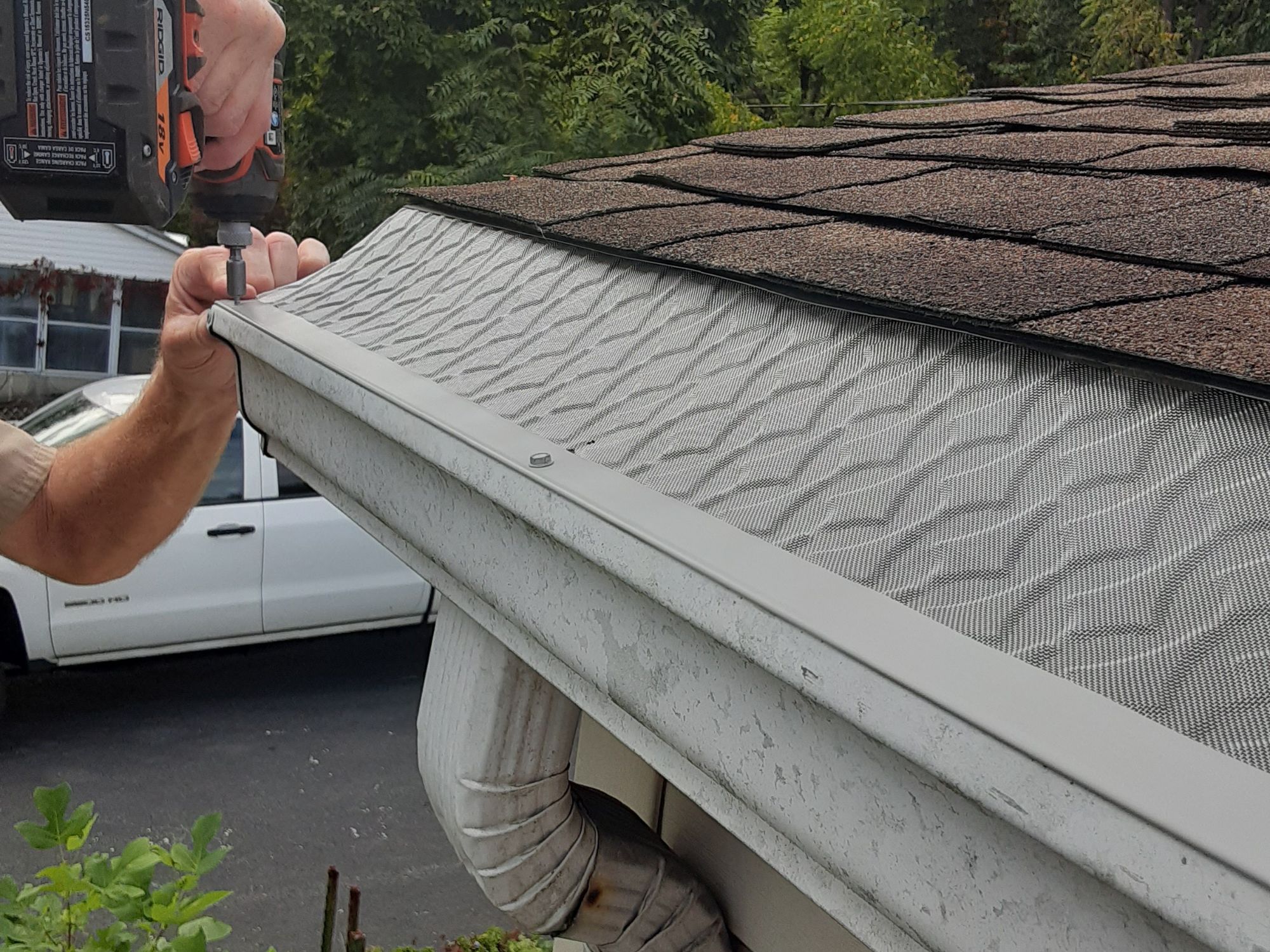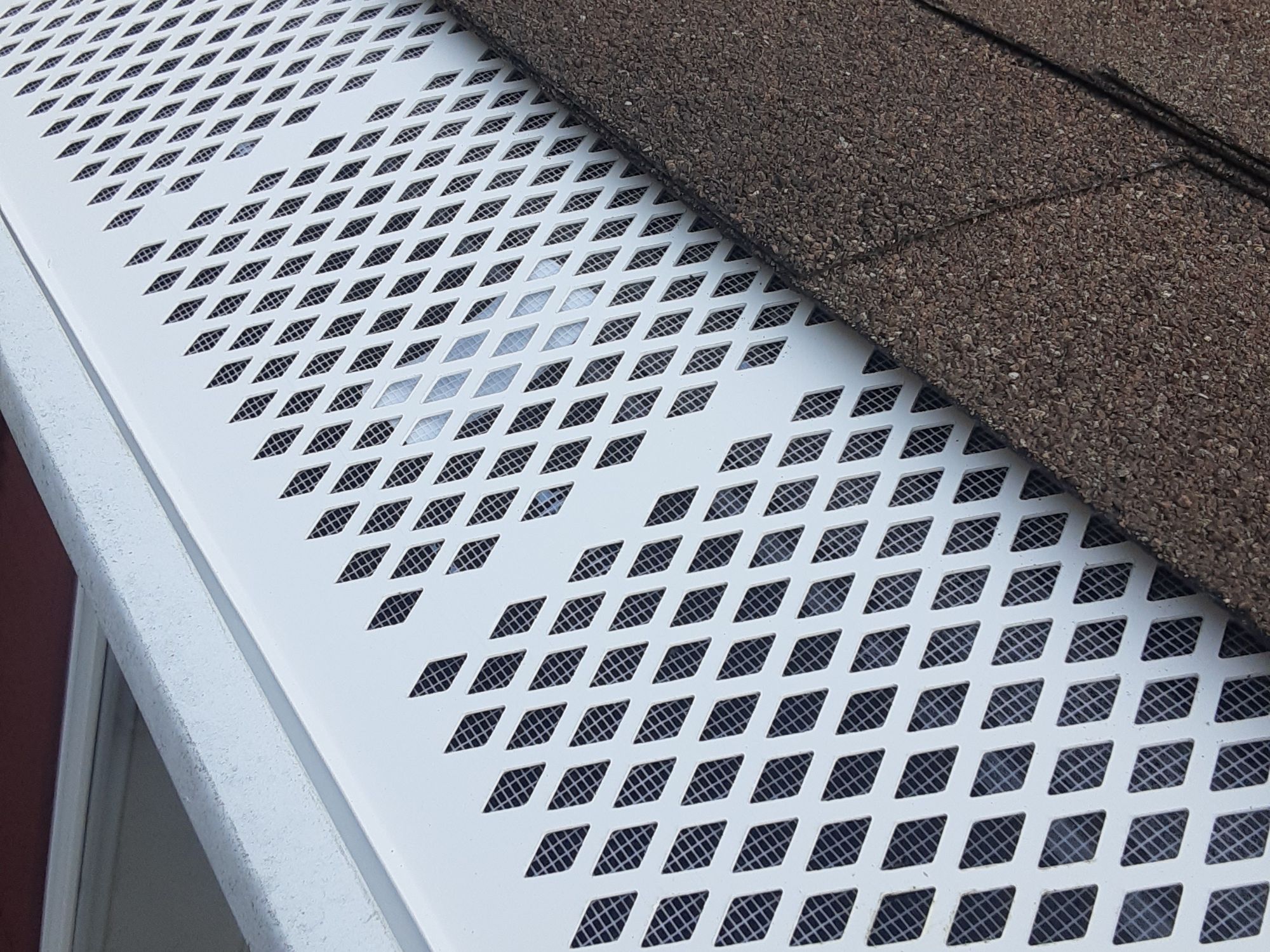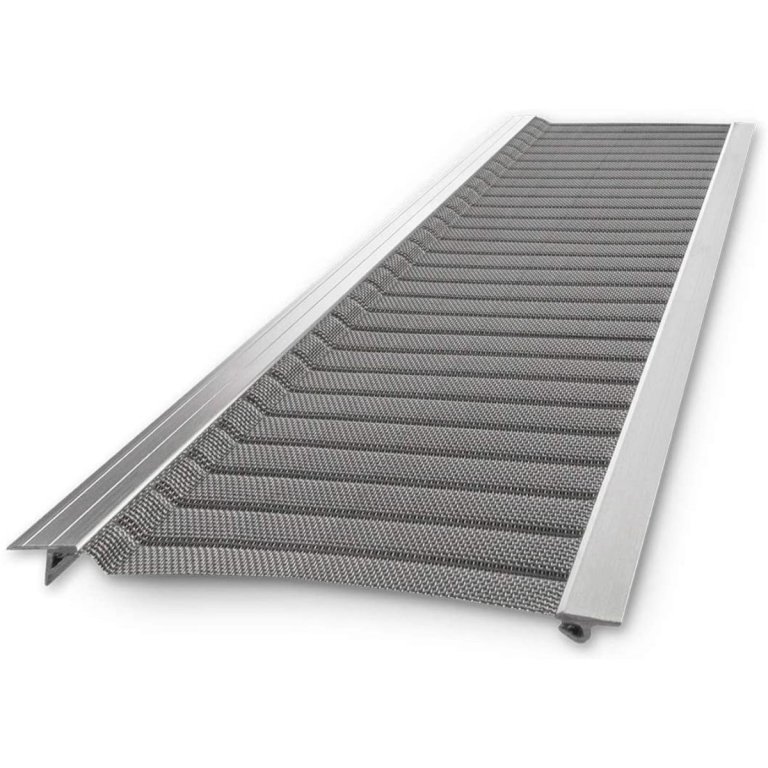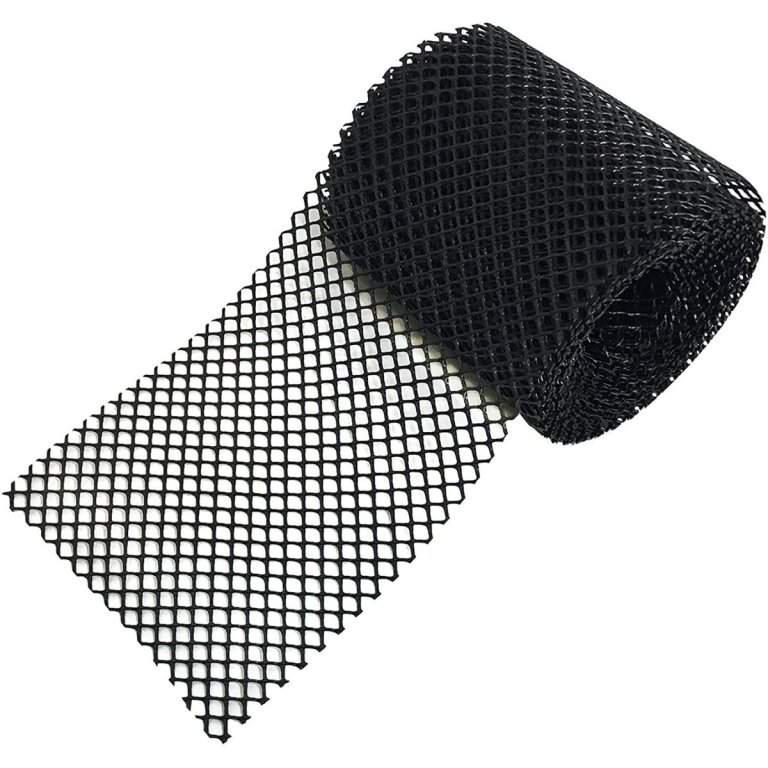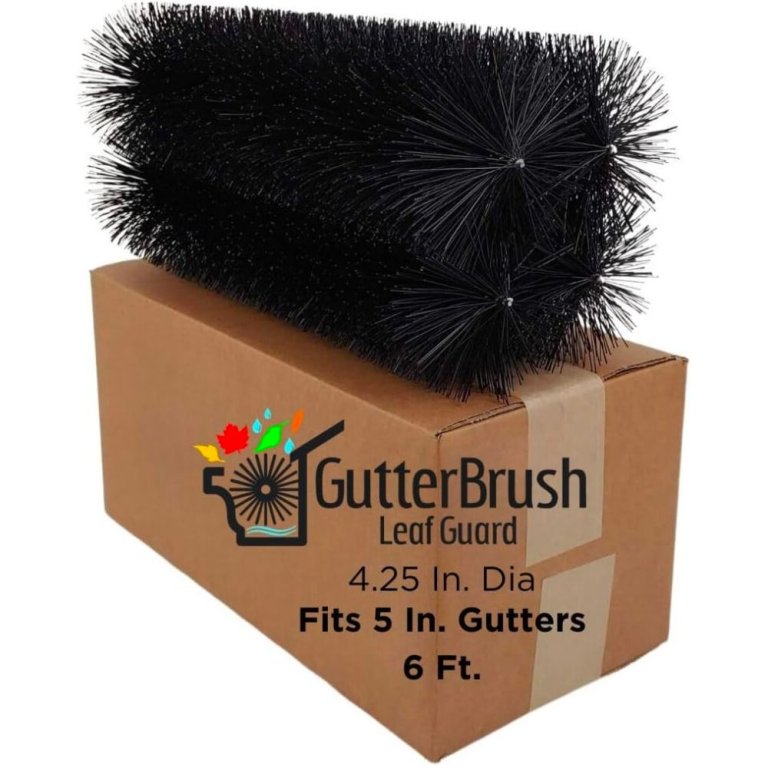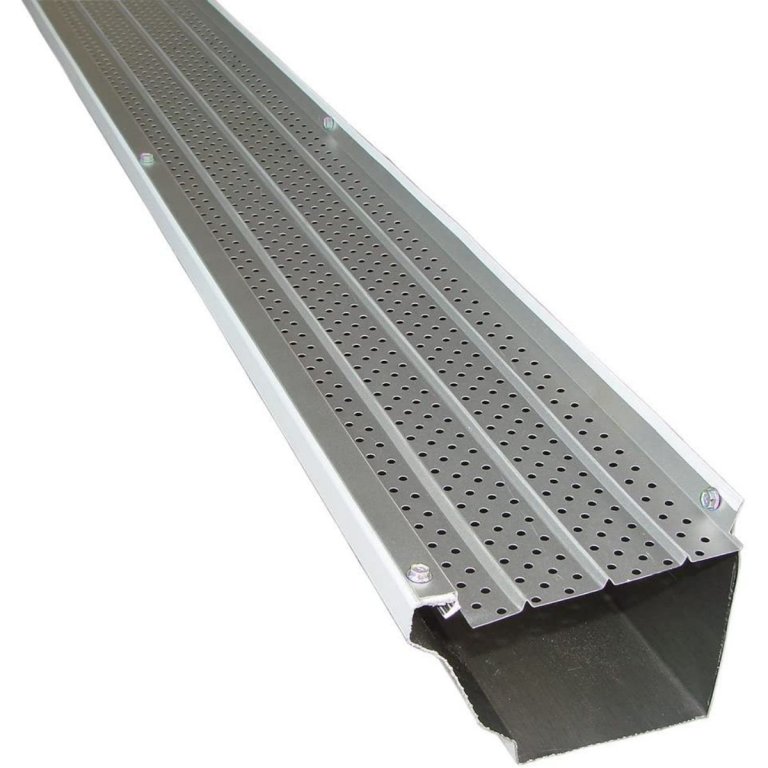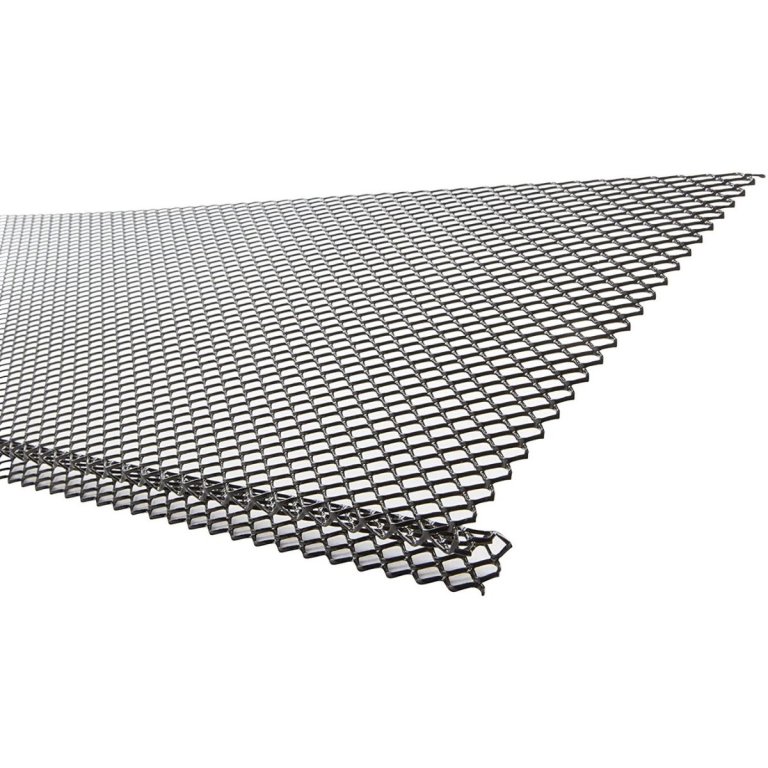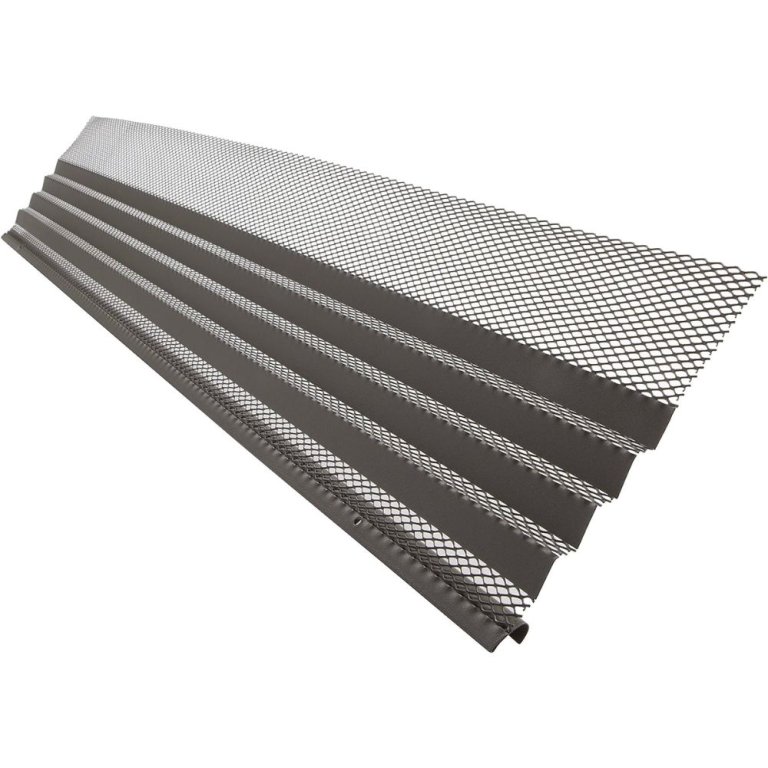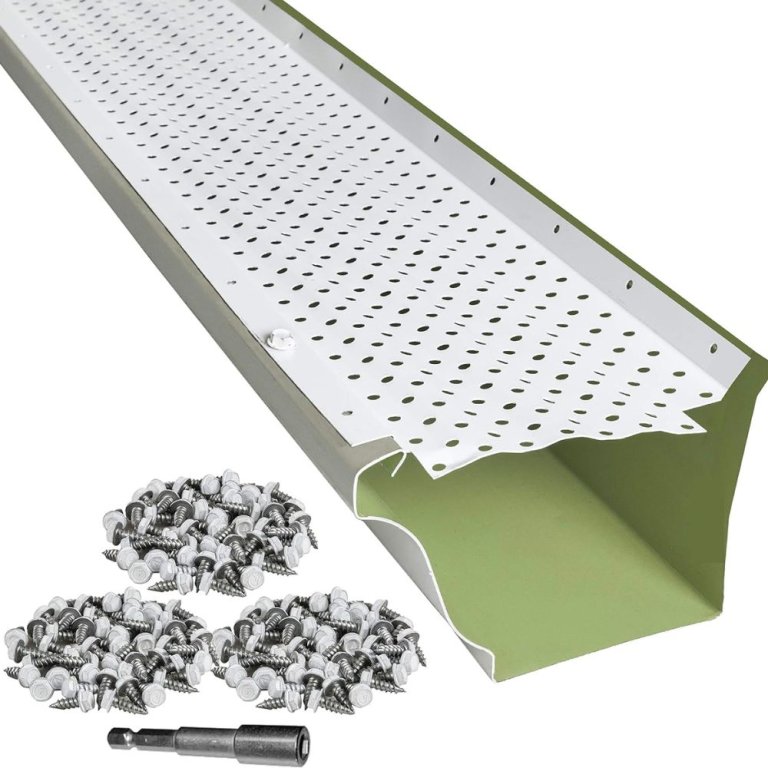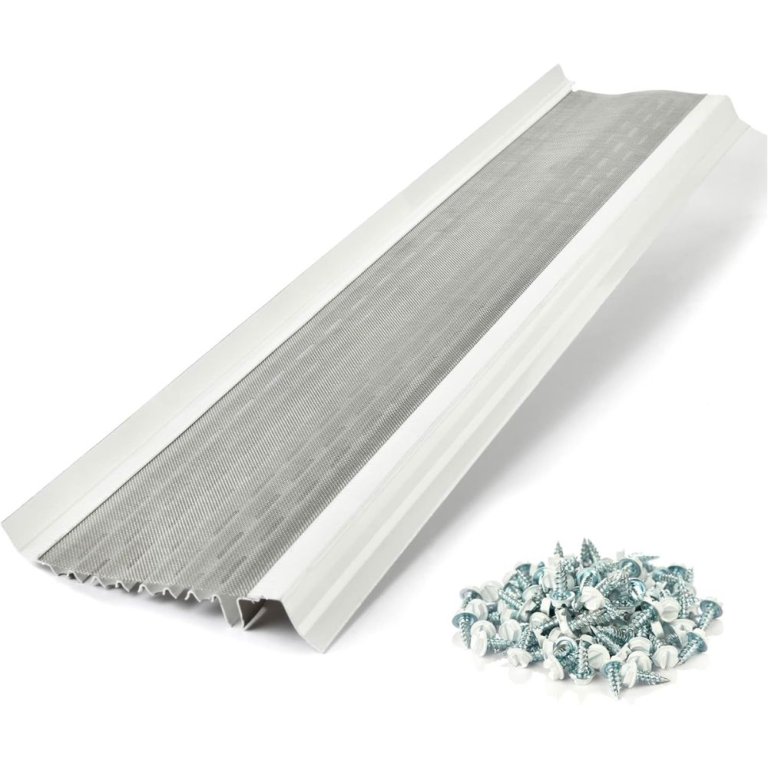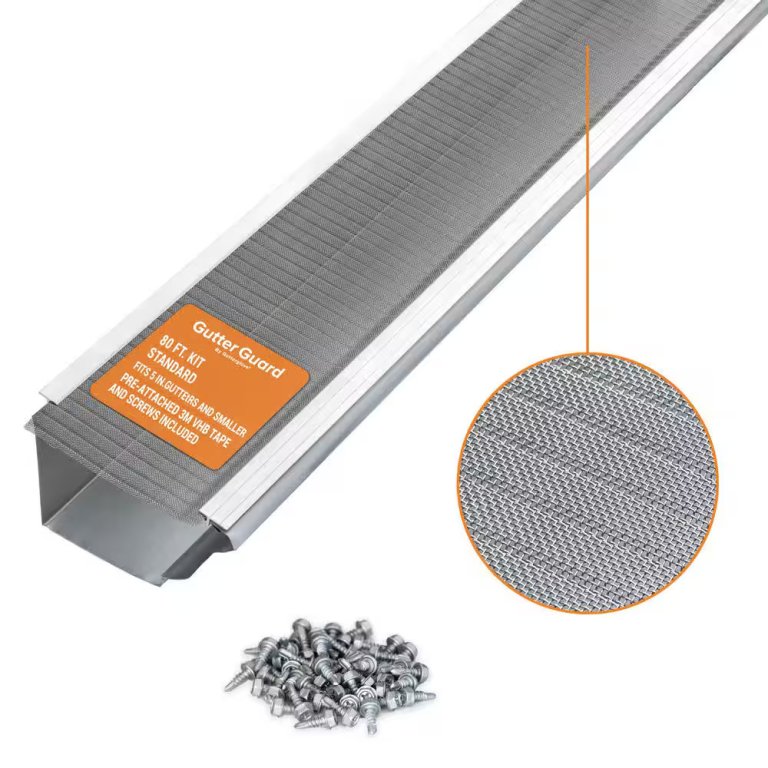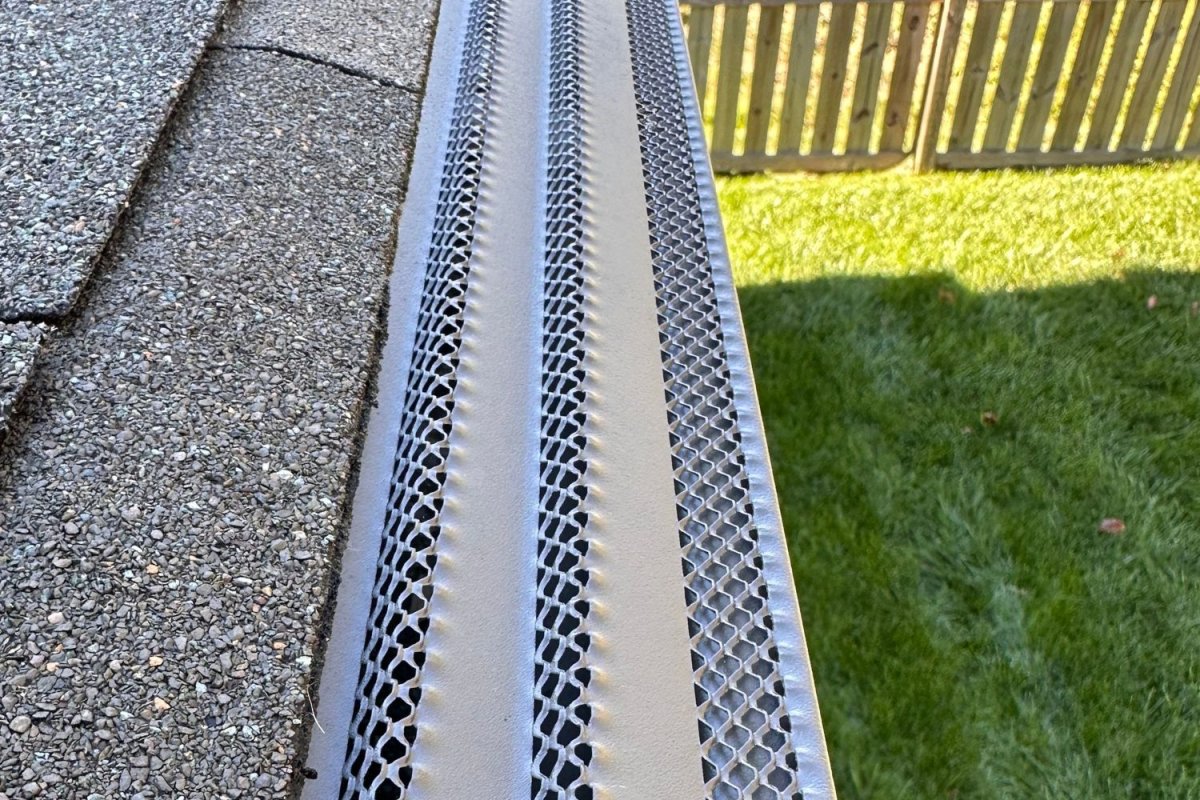
We may earn revenue from the products available on this page and participate in affiliate programs. Learn More ›
Gutter guards can prevent clogs caused by decomposing leaves, twigs, pine needles, and other debris, and keep rainwater flowing through downspouts. We tested a host of these products in different categories to judge performance on a variety of levels.
We liked the Raptor Stainless Steel Micro-Mesh Gutter Guards for their durable stainless steel construction and flexible mounting options, but these weren’t the only guards we liked.
Keep reading to learn more about leaf filter gutter protection and our hands-on-tested recommendations for more of the best gutter guards on the market.
- BEST OVERALL: Raptor Stainless Steel Micro-Mesh Gutter Guard
↓ Jump to Review - BEST BANG FOR THE BUCK: Frost King Plastic Mesh Gutter Guard
↓ Jump to Review - BEST BRUSH: GutterBrush 5-Inch Gutter Guard 6-Foot Trial Pack
↓ Jump to Review - BEST HEAVY-DUTY: FlexxPoint 5-Inch Residential Gutter Guard
↓ Jump to Review - LEAST NOTICEABLE: A-M 5-Inch Aluminum Gutter Guard
↓ Jump to Review - EASIEST TO INSTALL: Amerimax Lock-In Metal Mesh Gutter Guard
↓ Jump to Review - BEST FOR DOWNPOURS: Amerimax Hoover Dam Metal Mesh Gutter Guard
↓ Jump to Review - BEST FOR SHINGLE WARRANTY: LeafTek 5-Inch DIY Gutter Guard System
↓ Jump to Review - BEST MICRO-MESH: Waterlock Micro-Mesh 5-Inch Aluminum Gutter Guard
↓ Jump to Review - BEST FOR WIDER GUTTERS: Gutter Guard by Gutterglove
↓ Jump to Review
How We Tested the Best Gutter Guards
Our goal is to suggest only the best gutter guards available, so our hands-on testers installed the products, considered performance, and removed each product to ensure we knew exactly how each worked.
First, we installed one section of each gutter guard according to the directions, cutting for brackets when necessary. We assessed the flexibility of installation (no two sets of gutters are the same) as well as the quality of the hardware and how difficult each was to install. In most cases, professional installation is not required and can be done by the average DIYer. We observed the gutter guards from the ground to determine aesthetics and visibility.
We then left the gutter guards to collect debris, but since things had been relatively calm in our area at that time and there wasn’t a lot of debris coming down naturally, we took matters into our own hands. We used mulch to simulate twigs, tree dirt, and other debris, scooping it onto the roof above the gutters. Then, after hosing the roof down, we could accurately assess how well the gutters caught the debris.
We removed the gutter guards to access the gutters and determine how well the guards kept out debris. Finally, we cleaned these leaf guards for gutters to evaluate how easy it was to remove any clinging debris. After tallying the results, we created the following list of our top picks.
Our Top Picks
Put an end to semiannual gutter cleaning with one of the following options, each a high-quality gutter guard in its category. We evaluated every option as a top performer by putting them through their paces with hands-on testing. If your gutters need a larger overhaul, check out our choices for new gutters while also keeping these top considerations in mind as options to help maintain the longevity of your gutters.
Best Overall
Raptor Stainless Steel Micro-Mesh Gutter Guard
Buy at AmazonWhat We Like
- Stainless steel mesh blocks fine debris
- Flexible mounting for multiple gutter sizes
- Easy to remove for cleaning
What We Don’t Like
- Difficult to cut, even with snips
Product Specs
- Style: Micro mesh
- Material: Stainless steel and aluminum
- Visible: Depends on the installation method
This Bob Vila Approved product carries our brand’s highest level of recommendation.

Bob Vila Approved recognizes the household and DIY products that impressed us most in our real-world testing and that exemplify core values of the Bob Vila brand, including craftsmanship, innovation, and value for the dollar. Winners of this designation come recommended by our professional review team and are personally approved by Bob Vila.
The Raptor Gutter Guard is a standout choice for homeowners who want reliable, long-term protection without hiring a pro. Made from durable stainless steel, its fine micro-mesh blocks everything from leaves and pine needles to tiny windblown seeds, ensuring gutters stay clear and water keeps flowing. We liked that the guard offers flexible installation options—it can slide under the shingles or mount directly across the gutter edge—making it a versatile fit for different rooflines.
During testing, the mesh stayed taut thanks to Raptor’s V-Bend technology, which strengthens the screen and prevents sagging under heavy debris. While cutting the stainless steel sections to size took some muscle (a reminder of the product’s sturdiness), once installed, the guards were easy to maintain. They’re also simple to remove if you want to clean out the gutters directly.
Each kit comes with 48 feet of coverage in manageable 5-foot strips, along with self-tapping hex screws and the driver bit you’ll need for installation. Overall, Raptor combines durability, effective filtration, and DIY-friendly design, making it one of the most dependable gutter guard systems we tested.
Get the Raptor gutter guards at Amazon.
Best Bang For The Buck
Photo: AmazonWhat We Like
- Easy to cut; fits multiple gutter sizes
- Very affordable compared to similar options
- Lightweight plastic screen; simple to install
What We Don’t Like
- Tricky to install for first-time users
Product Specs
- Style: Screen
- Material: Plastic
- Visible: In most cases, yes
For those who prefer not to invest in an expensive stainless steel product, this Frost King gutter guard is an affordable plastic option that keeps the gutter system safe from large debris and nuisance pests, like mice and birds. The plastic screen gutter guard can be cut with standard scissors for a custom fit to the gutter, and it comes in a 6-inch-wide by 20-foot-long roll.
The gutter guard installs easily without screws, tacks, nails, or any other fastener. Just place the guard into the gutter, ensuring that the center of the guard is bent up toward the opening of the gutter instead of forming a trough where debris would collect. The plastic material won’t rust or corrode, and it’s fairly resistant to extreme temperature changes, protecting the gutters all year long.
In testing, the affordable Frost King system proved to be a decent option. The screen was easy to cut to 4- and 5-foot lengths while on the ground, and the plastic is so lightweight, we had no concern about carrying it up a ladder (which can be a challenge with heavier materials). However, we found these leaf guards for gutters to be somewhat finicky to install correctly, as they don’t use hardware to hold them in place.
Get the Frost King gutter guards at Amazon, The Home Depot, or Walmart (5-pack).
Best Brush
GutterBrush 5-Inch Gutter Guard 6-Foot Trial Pack
Buy at Amazon Buy at the Home Depot Buy at GutterBrushWhat We Like
- Incredibly easy to install versus other guards
- Universal fit for standard-size gutters
- Allows strong water flow; prevents congestion
What We Don’t Like
- Clogs if not cleared and cleaned regularly
Product Specs
- Style: Brush
- Material: Polypropylene bristles
- Visible: No
This brush gutter guard has a flexible wire core made of stainless steel that can bend around corners. The brush bristles, made of ultraviolet-resistant polypropylene, extend out about 4.5 inches from the core, allowing the entire gutter guard to fit comfortably into standard-size 5-inch gutters.
The gutter cover comes in a range of lengths from 6 to 420 feet, and it’s very easy to install without fasteners: Simply place this leaf guard into the gutter and push down gently until the guard is sitting at the bottom of the gutter. The bristles allow water to flow freely through the gutter while preventing leaves, sticks, and other large debris from entering and clogging the drainage system.
In testing, the beauty of the GutterBrush’s gutter-guard system proved to be the easy installation, as described above. The system works for fascia-mounted brackets as well as shingle-mounted ones, making this the most universal of all gutter guards we tested. They allow for ample water flow, but we did find them prone to clogging with larger debris. While big pieces are easy to remove, we learned that the GutterBrush isn’t a maintenance-free solution.
Get the GutterBrush gutter guards at Amazon (4-pack), The Home Depot (6-pack), or GutterBrush (4-pack).
Best Heavy-Duty
Photo: AmazonWhat We Like
- Heavy-duty build withstands harsh weather conditions
- Secure installation with 4-foot sections
- Includes fasteners for 3-point design
- Invisible from ground; clean roofline look
What We Don’t Like
- Can clog and need quick attention
- Requires regular upkeep and maintenance
Product Specs
- Style: Screen
- Material: Aluminum
- Visible: No
The FlexxPoint residential gutter cover system offers enhanced protection from sagging and collapse, even under heavy leaf or snow accumulation. It’s reinforced with raised ridges that run the length of the strip, featuring a lightweight, rustproof aluminum build. The screen gutter guard has a subtle design that can’t be seen from the ground.
Certain features of the FlexxPoint residential gutter cover system made it stand out during testing. It was the only system that required screws in both the front of the gutter and in the back. This extra connection makes it extremely heavy duty and stable—it won’t come out on its own under most conditions. And while it’s very durable, it’s not difficult to cut.
This reliable gutter guard attaches to the outer edge of the gutter with included ½-inch #8 stainless steel zip screws. It snaps into place, so there’s no need to slip it under the shingles. With color choices of black, white, brown, and matte aluminum, it is available in lengths of 22; 102; 125; 204; 510; 1,020; and 5,100 feet. It can’t be seen from the ground, which is a huge plus for a heavy-duty guard. However, we found that it will collect larger debris, which must be manually (though easily) removed.
Get the FlexxPoint gutter guards at Amazon, Walmart (102 feet), or FlexxPoint.
Least Noticeable
A-M 5-Inch Aluminum Gutter Guard
Buy at AmazonWhat We Like
- Easy to cut and install around brackets
- Invisible from ground; prevents cluttered look
- Reinforcement ridges withstand harsh weather
What We Don’t Like
- Requires regular maintenance for effectiveness
- Can clog with larger debris
- Does not include self-tapping screws
Product Specs
- Style: Screen
- Material: Aluminum
- Visible: No
Those who don’t want gutter guards to show from below might want to consider the A-M 5-inch aluminum gutter guard. Made from industrial-grade aluminum, the perforated panel contains 380 ⅛-inch holes per linear foot to handle heavy downpours. It fits snugly inside the top of the gutter and is virtually invisible once installed, so it won’t detract from a roof’s good looks.
Containing slip-under shingle support and tabbed for easy installation, the guard attaches to the gutter’s outer lip with self-tapping screws (not included). Designed for 5-inch gutters, it comes in 23-, 50-, 100-, and 200-foot lengths. This product is also available for 6-inch gutters in 23-, 50-, 100-, and 200-foot lengths.
In testing, we developed a love-hate relationship with the A-M gutter-guard system. Yes, these aluminum gutter guards are a high-quality system with strong reinforcement ridges running the length of the guard, and they can’t be seen from the ground. They’re easy to cut and install, even around brackets, and they do a good job of allowing water flow and collecting debris. But they don’t come with the necessary self-tapping screws! All the other systems that required fasteners included them. Also, this system will clog with larger debris, so it will require light maintenance eventually.
Get the A-M gutter guards at Amazon.
Easiest to Install
Photo: AmazonWhat We Like
- Flexible installation for different comfort levels
- Easier to cut than similar options
- Locking design withstands harsh weather
What We Don’t Like
- Difficult to install around brackets or remove
Product Specs
- Style: Mesh
- Material: Powder-coated steel
- Visible: Probably
Even a novice DIYer may find it a snap to get their gutter guards installed with the Amerimax Metal Lock-In gutter guard. This screen-type gutter guard is designed to slip under the first row of shingles and then snap over the outer edge of the gutter. Its flexible design accommodates 4-, 5-, and 6-inch K-style gutter systems.
Made from powder-coated steel to resist rust, the Amerimax gutter guard will keep leaves and debris out while permitting even the heaviest downpour to flow through. It comes in easy-to-handle 3-foot strips and can be installed without tools. This hardware-free installation performed very well in testing and was so secure, it proved a bit challenging to remove the gutter guard by hand.
The screen was easy to cut, and we appreciated the flexible mounting option (we couldn’t get it under our shingles, so we put it across the top of the gutter). It did a good job of keeping debris out, though smaller bits made their way in. But the only real issue involved removing the guard, as the cut mesh hung up on the brackets.
Get the Amerimax Lock-In gutter guards at Amazon (25-pack), Lowe’s, or The Home Depot.
Best for Downpours
Photo: AmazonWhat We Like
- Durable steel-alloy with powder coating
- Raised ridges prevent water overflow
- Easy to cut and install
What We Don’t Like
- Debris collects on ridges; needs cleaning
- 7-inch width causes bump on 5-inch gutters
Product Specs
- Style: Mesh
- Material: Powder-coated steel
- Visible: Yes
Amerimax’s aptly named Hoover Dam gutter guard, which comes in a 7-inch-wide by 3-foot-long size, keeps debris out of the gutters without impeding the flow of water. Its angled ridges are designed to catch fast-moving water as it flows over the guard, redirecting it into the gutter and preventing it from flowing over the top.
There are several things we liked and few things we didn’t about the Hoover Dam during testing. We loved the build quality of these guards. They’re made of a heavier gauge alloy steel than other guards we tested, and they’re sealed with a powder coating. Though we only tested them for a couple of weeks, they feel like they’ll hold up to harsh weather for years.
We also liked how easy they were to install. One side slides under the shingles while the other snaps onto the inner edge of the gutter and secures in place with self tapping metal screws. That said, we didn’t like their one-size-fits-all design. The guards, which can also fit 6-inch gutters, were very wide for our 5-inch gutters, forcing us to slide them so far under the shingles that it created a noticeable bump. We also didn’t like the fact the edge of the gutter is visible from the ground.
In terms of performance, the Hoover Dam does an excellent job of keeping leaves, twigs, and most debris out. That said, these gutter guards are not micro mesh, so they won’t stop asphalt shingle granules from passing through and accumulating in the gutters, which could eventually lead to clogs.
Water flow with the Hoover Dam was great thanks to those ridges that catch water as it flows off the roof. We observed no overflow, even during a late summer deluge. Unfortunately, those ridges were also great at trapping debris, which could eventually clog the mesh and cause water to run over the top of the guards if they aren’t cleared off periodically. Luckily, cleaning them was a breeze. It was easy to sweep debris off with a brush or even blow it off with a small cordless blower.
Get the Amerimax Hoover Dam gutter guards at Amazon or The Home Depot.
Best for Shingle Warranty
LeafTek 5-Inch DIY Gutter Guard System
Buy at AmazonWhat We Like
- Securely attached with screws; prevents warping
- Blocks leaves, twigs, debris; allows water flow
- Installs inside gutters; no roof interference
What We Don’t Like
- Many screws make installation more laborious
Product Specs
- Style: Screen
- Material: Powder-coated steel
- Visible: No
LeafTek’s gutter guards are designed to fit inside the gutter instead of sliding under the shingles, making them an ideal choice for those worried about voiding their roof warranty with gutter guards. Each side of the aluminum guards have preset holes for attaching them to the gutter using metal screws.
The guards are made from heavy-gauge aluminum and come in two different sizes to fit 5-inch and 6-inch gutters. Small ⅛-inch holes keep twigs, pine needles, and leaves out of the gutter while allowing water and asphalt sediment to pass through. And since they’re slightly recessed inside the gutter, they remain invisible from below.
During testing, we had mixed feelings about these guards. While we liked that the no-tuck design keeps them separate from the shingles, we didn’t like how difficult they were to install. It was particularly hard to secure the backside of the guards to the gutters. Since the shingles on our roof run over the gutters by several inches, we had to hold back shingles to drive screws into the back of the guards all while teetering on a ladder.
Once installed, we liked how these gutters looked and performed. LeafTek guards aren’t visible from below, nor do they create any odd bulges under the shingles. And since they’re held together with so many screws, these guards aren’t going to easily shift, warp, or pop out.
The guards also did a great job of keeping debris out during testing, including leaves, twigs, and other debris. However, they didn’t shed debris well. Since the guards sit recessed inside the gutter, they trap debris on top of them. This recessed design also made it a bit more difficult to clean them off than guards that sit on top of the gutters.
Get the LeafTek DIY gutter guards at Amazon.
Best Micro-Mesh
Photo: AmazonWhat We Like
- Micro-mesh blocks all debris, even shingle granules
- Tuck-in design needs few screws; easy install
- Deep channels prevent splashing; add sturdiness
- Available in 14 exterior-matching colors
What We Don’t Like
- Costs twice as much as other guards
Product Specs
- Style: Micro mesh
- Material: Aluminum
- Visible: Yes
Those looking for gutter guards that are easy to install and keep just about everything out may need to look no further than Waterlock micro-mesh gutter guards. They feature tight-woven micro mesh that’s designed to keep everything from leaves to asphalt granules out. The guards come in both 5-inch and 6-inch widths and install by tucking under the shingles and snapping into the front of the gutter.
There was a lot to like about the micro-mesh gutter guards during testing. With a design that requires only four or five screws per section, they were relatively easy to install. We also liked the level of protection these guards supply. After 2 weeks of testing and several heavy rains, we found that the micro mesh stopped everything from leaves and twigs to asphalt granules. The Waterlock guards come equipped with deep channels under the mesh that prevent water from jumping out and splashing over the gutter during heavy rains.
And, unlike some of the micro-mesh guards we tested, this micro mesh has a more substantial feel thanks to those channels under the mesh. In short, these guards feel like they’ll last a long time and hold up against nasty winter weather. Micro mesh is also one of the few gutter guards that may actually add to the look of a home. The large lip and back of the guards are visible from below. Waterlock encourages buyers to use this to add style to a home by offering 14 different color options for this exposed lip, including such colors as bronze, red, black, and copper.
While these guards perform well and are easy to install, it’s important to note that they’re also among the most expensive at more than $5 per linear foot.
Get the Waterlock gutter guards at Amazon or Walmart.
Best For Wider Gutters
Gutter Guard by Gutterglove
Buy at The Home DepotWhat We Like
- Fits 6- and 7-inch gutters
- Blocks pine needles and fine grit
- Rigid stainless steel micro-mesh
- Two installation options included
What We Don’t Like
- More costly than standard guards
- Cutting sections can be difficult
Product Specs
- Style: Micro mesh
- Material: Stainless steel
- Visible: Depends on the installation method
The Gutter Guard by Gutterglove is an excellent option for homeowners with oversized gutters, available in widths up to 7.25 inches to cover 6- and 7-inch systems. Its stainless steel micro-mesh paired with V-Bend technology delivers top-notch filtration, keeping out leaves, pine needles, and even fine grit while maintaining steady water flow. Side by side, it’s almost indistinguishable from our top pick, the Raptor, which speaks to its quality.
In testing, the guard’s rigid frame held up well under heavy layers of debris without bending or sagging. We also appreciated the two installation choices: the included self-tapping screws for a secure, permanent fit or pre-applied 3M VHB tape for faster setup. Both options made installation relatively straightforward, though the screw method is the sturdier long-term solution.
For anyone with wider gutters—or simply looking for a premium guard built to last—Gutter Guard by Gutterglove delivers performance that rivals the best on the market, with durability and flexibility that make it worth the investment.
Get the Gutter Guard by Gutterglove at The Home Depot.
Jump to Our Top Picks
What to Consider When Choosing Gutter Guards
There are a few things to keep in mind when trying to find the best gutter guards to protect a home. These include type, material, size, visibility, and installation.
Types of Gutter Guards
The five main types of gutter guards available are screen, micro mesh, reverse curve (or surface-tension gutter guards), brush, and foam. Each type has its own set of advantages and considerations.
Screen
Screen guards feature a wire or plastic grid that blocks leaves from entering the gutter trough. They’re easy to install by lifting the bottom row of roof shingles and sliding the edges of the gutter screens beneath the shingles along the entire length of the gutter; the weight of the shingles holds the screen in place. Screen gutter guards are an inexpensive option and offer the simplest installation—often, no tools are needed.
Gutter screens are not screwed down and so may be dislodged by high winds or knocked out from under shingles by falling branches. Additionally, prying up the lower row of roof shingles to install slip-under gutter guards voids certain roof warranties. Buyers might want to contact the shingle manufacturer before installing this type of gutter guard if they have concerns.
Micro Mesh
Steel micro-mesh gutter guards are similar to screens, allowing water to run through small holes while blocking twigs, pine needles, and debris. They require one of three simple installation methods:
- Slip the edge under the first row of roof shingles.
- Snap the guard directly onto the top of the gutter.
- Attach a flange to the fascia (the vertical strip just above the top of the gutter).
Micro-mesh gutter guards are effective at blocking even small bits of debris, such as blowing sand, while allowing rain to flow through. They’re made of various materials, from inexpensive plastic gutter guards to strong stainless steel ones.
Unlike other gutter guards, even the best mesh gutter guards may require occasional cleaning with a hose sprayer and scrub brush to clear ultrafine debris from the mesh holes.
Reverse Curve
Reverse-curve gutter guards are made from lightweight metal or molded plastic. Water flows over the top and around a downward curve before dropping into the gutter beneath. Leaves and debris slide right off the edge and fall to the ground below. These gutter guards work well for keeping leaves and debris out of the gutter, even in yards with numerous trees.
Reverse-curve gutter guards are more expensive than mesh guards and screen options. They’re less DIY-friendly than other types of gutter guards and must attach at the correct angle to the roof’s fascia. If not installed properly, water can run over the edge rather than following the reverse curve into the gutter. Since they install above the existing guttering, these guards can appear like full gutter covers from the ground, so it’s advised to look for a product that matches the color and aesthetic of the home.
Brush
Brush-style gutter guards are essentially oversize pipe cleaners that rest inside the gutter, preventing large debris from falling into the gutter and causing clogs. This type of gutter guard is typically composed of a thick metal wire core with polypropylene bristles extending from the center.
The guards require no screws or connections to the rain gutters, and the metal wire core is flexible, allowing the gutter guards to be bent to fit around corners or unusually shaped stormwater drainage systems. Simply cut the brush to the proper length and slide it into the gutter. The easy installation and inexpensive price makes brush-style gutter guards a popular option for DIYers on a budget, and they makes it easier for DIYers to install these gutter guards without professional assistance.
Foam
Another easy-to-use option is essentially a triangular block of foam that sits in the gutter. One flat side lies to the back of the gutter; another flat side faces up to the top of the gutter to prevent debris from entering. The third flat side lies diagonally in the gutter, which allows water and small debris to flow through the drainage system.
Foam gutter guards are inexpensive and easy to install, which is ideal for DIYers. Gutter foam can be cut to the proper length, and the guards don’t require nails or screws to remain in place, so there’s less risk of damage or leaks. However, they aren’t the best for locations that experience high levels of precipitation because heavy rain can quickly saturate the foam, causing the gutters to overflow.
Material
Gutter-guard materials can vary depending on the type and quality of the product. Here are the most common types of materials.
- Stainless steel is commonly used to make micro-mesh, screen, and reverse-curve gutter guards. It’s one of the most durable options, though typically more expensive. Stainless steel is resistant to rust, corrosion, and temperature extremes, preventing the gutter guards from expanding, warping, and cracking.
- Copper screen and micro-mesh gutter guards are highly resistant to rusting and corrosion. Typically more resilient (and more expensive) than any other type, copper gutter guards can also be hard to find, as few manufacturers produce them.
- Aluminum, a comparatively affordable metal, is used to make lightweight micro-mesh and screen gutter guards. Though they’re not as rugged as stainless steel or copper options, durability isn’t as important for homes that don’t have overhanging tree branches because there’s less chance for branches, twigs, pine needles, and other hard objects to pierce the guard.
- Plastics are regularly used to make the frame of gutter guards for both reverse-curve and brush guards. However, brush guards typically have a core of stainless steel or aluminum, while the brush bristles are usually made from polypropylene. Plastic is inexpensive, and it doesn’t rust or corrode, but it is prone to swelling and cracking.
- Foam is the only material used in foam gutter guards. The entire guard is essentially a block of foam that allows water to filter through the material while preventing large debris from falling into the gutter. Foam is an inexpensive, durable material, but it is susceptible to mold growth.
Size
Choosing the correct size requires climbing up on a secured ladder to measure the width of the gutter. The length of each gutter must also be measured to determine the correct size as well as the number of gutter guards necessary to protect the entire gutter system.
Most gutter guards come in lengths ranging from 3 to 8 feet. Gutters come in three standard widths, with guards sized to match 4 inches, 5 inches, and 6 inches, with 5 inches being most common. To get the correct-size guard, measure the width of the top of the gutter from the inside edge to the outside edge.
Visibility
Depending on the type of gutter guard that is used, the side or even the top may be visible from the ground. Foam and brush gutter guards are essentially invisible from the ground because they sit completely in the gutter, but micro-mesh, screen, and reverse-curve gutter guards are more visible. For other types, it’s best to find a guard that highlights the house or blends in with the existing aesthetic.
Generally, guards come in three standard colors: white, black, and silver. Some products are available in additional color options, allowing users to find guards that match the gutters or other features of the home. Matching the gutter guards to the color of the roof is also a good way to obtain a cohesive, attractive look.
Professional vs. DIY Installation
Professional installation is strongly recommended for anything higher than a 1-story roof. With 1-story houses, this is a relatively safe and simple job that requires only basic tools.
Avid DIYers equipped with an appropriate ladder who are experienced working at heights will most likely be able to install their own gutter guards on a 2-story house, as long as safety precautions are followed.
Never go up on a ladder to the roof without a spotter. Ensure that a proper fall-safety system is in place to prevent serious injuries.
The Advantages of Owning Gutter Guards
The main benefit of using gutter guards to protect the stormwater drainage system is keeping debris out. Leaves, sticks, feathers, and other large debris can quickly clog up a gutter system, preventing water from properly draining. Once formed, these clogs grow as mud clings to the clog, filling in gaps and potentially attracting pests.
Rodents and insects that are drawn to wet, dirty gutters can make nests or use the proximity to the home to begin burrowing into the roof and walls. However, installing gutter guards helps keep out these nuisance pests and protect the home.
With gutter guards preventing debris buildup and pest infestations, the gutters remain relatively clean, so they only need to be thoroughly washed out once every few years, saving time and effort. The gutter guards still need to be inspected semi-regularly—and after big storms—to clean away any debris from the top of the guard that could be limiting the flow of water into the gutters.
- By using gutter guards, the gutter system remains free of such large debris as leaves and sticks.
- Gutter guards help keep rodents and larger insects from nesting in damp gutters, thereby causing the drainage system to back up.
- The maintenance of gutters is easier when gutter guards are used to prevent obstructions from entering the stormwater drainage system.
FAQs
Gutter guards offer an excellent way to reduce maintenance and protect the gutters from debris buildup and pest infestations. If you still want more info about how gutter guards work and how to maintain them, keep reading for answers to some of the most frequently asked questions about these products.
Installation methods depend on the type of gutter guard. While some do not go under shingles, other products do install under the first or second row of shingles.
Handling heavy rain is entirely possible for most gutter guards, though guards that are full of leaves or sticks may have a hard time passing the quickly flowing water. This is why it’s important to inspect and clean both the gutters and the guards in spring and fall seasons when falling debris from nearby foliage is at its worst.
Some gutter guards, like reverse-curve guards, can worsen ice dams by trapping snow and ice inside the gutter. However, most gutter guards help prevent ice buildup by limiting the amount of snow that passes through into the gutter system.
While gutter guards do help to keep out larger debris, the gutters still need to be cleaned. Follow these simple steps to clean the gutters without removing the gutter guards.
1. Place a drop cloth at the bottom of the ladder to catch falling debris.
2. Set up and secure the ladder to prevent it from falling or shifting.
3. Don safety gloves and climb up the ladder to access the gutters.
4. Remove any debris that’s built up on the top of the gutter guards.
5. Rinse the gutters with a hose or a pressure washer to break up any clumps of small debris and clean out excess dirt and other material.
6. Move to the next section of the gutter and repeat, continuing until the stormwater drainage system is completely clean.
Gutters equipped with gutter guards needn’t be cleaned often, as long as the top of the gutter guard is kept relatively free of leaves and sticks. A thorough cleaning once every 2 years is typically enough to keep the main stormwater drainage system free of debris.
However, it’s recommended to check the gutter guards for excess debris during the spring and fall seasons, as well as inspecting the gutters for ice dams during the winter to prevent damage to the gutter system.
Why Trust Bob Vila
Bob Vila has been America’s Handyman since 1979. As the host of beloved and groundbreaking TV series including “This Old House” and “Bob Vila’s Home Again,” he popularized and became synonymous with “do-it-yourself” home improvement.
Over the course of his decades-long career, Bob Vila has helped millions of people build, renovate, repair, and live better each day—a tradition that continues today with expert yet accessible home advice. The Bob Vila team distills need-to-know information into project tutorials, maintenance guides, tool 101s, and more. These home and garden experts then thoroughly research, vet, and recommend products that support homeowners, renters, DIYers, and professionals in their to-do lists.
Meet the Tester
Tony Carrick is a freelance writer specializing in home improvement, landscaping, technology, home security, and design. His articles have been featured on such sites as Angi, Popular Science, Futurism, 360 Reviews by U.S. News & World Report, Domino, and more. Carrick has conducted rigorous product testing on everything from power tools to home security systems to backyard grills. With each review, his goal is to help readers determine whether a product meets their needs and if it is or isn’t worth its price tag.
Additional research and testing provided by Paul Rankin, Glenda Taylor, Timothy Dale, and Tom Scalisi.
